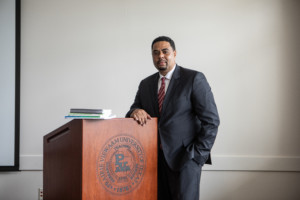PRAIRIE VIEW, Texas – Public school systems across the country face the challenge of mounting a sustainable educational space amid school closings and remote learning programs fueled by the ongoing COVID-19 pandemic. A Prairie View A&M University (PVAMU) educational leader is offering a path of success for Texas state education officials during the crisis.
Tyrone Tanner, Ed.D., executive director of PVAMU’s Northwest Houston Center and professor in the Whitlowe R. Green College of Education, recently delivered a keynote address at the Texas Education Agency’s Student Success Initiative (SSI) Community Partnership Schools Fall 2020 Conference in front of TEA officials, superintendents, principals, and teachers. Titled “Culturally Responsive Instructions during Remote/Virtual Existence,” the conference dealt with developing and supporting community partnerships within education. Appropriate to the virtual event, Tanner presented his speech remotely.
Drawing on his experience as a P-16 education professor and researcher, higher-education administrator, school board member, K-12 school administrator and teacher, Tanner focused on three key areas.
“I provided what it means to be culturally responsive in a virtual and face-to-face learning environment,” he said. “I also provided strategies on maintaining a healthy physical, intellectual, psychological, environmental, and social balance in a virtual and face-to-face learning environment; and recommendations for addressing social justice issues plaguing the society.”
Core Beliefs Set the Stage
Tanner presented a few essential values in education to fuel his presentation.
“A mind convinced against his will will remain unconvinced,” he said. “It doesn’t matter if you go through the process and do everything right. If people don’t see it, don’t agree with it, and don’t believe in it, we won’t get far,” he said.
Tanner pointed out the education system must embrace a new and different perspective that begins with caring enough to consider something new and that transforming organizations would require commitment, courage, and leadership.
A Culturally Responsive Learning Environment
Tanner has produced more than 30 peer-reviewed articles and books over the years, and a key focus is culturally responsive leadership, or understanding and considering the different cultural backgrounds of the students being taught. His presentation reflected that passion.
“When provided with a culturally responsive environment, all children can learn with exceptionality,” he said.
“A big part of cultural responsiveness is really looking at equity—looking at the challenges that we know exist in our community and our schools, and seeing what can we do,” Tanner told his audience.
To Test or Not to Test
Within the context of cultural responsiveness during the pandemic, Tanner addressed inequities in regard to testing effectiveness.
“I believe there is value in testing our students this year, as long as the goal is for the data to serve as a diagnostic tool,” he said. However, Tanner noted the danger of penalizing schools or districts for the 2020-21 year based on testing that ignores the “new normal” of the pandemic environment.
“The rating system was created and based on instruction taking place during a non–pandemic time; applying it in the midst of a pandemic will not yield reliable results,” he said.
A “New Normal” and its Effect on Some Minorities and Low-Income Students
While Tanner noted how much educators have learned during the COVID-19 process, teachers and school leaders have been tasked with shouldering an unrealistic instructional model. In many cases, educators are required to teach both online and face-to-face while caring for themselves and their families.
“As such, countless children did not receive engaging instruction or were forced to learn in the absence of necessary resources,” he said.
More troubling, the new learning challenges posed by the pandemic disproportionately affect Black and Brown students.
Recent studies show 30 percent of Black and Brown students were not actively engaged in learning during coronavirus-related changes, as opposed to only 6 percent of white students.
“The academic COVID-19 slide continues to impact Black, Brown, and low-income children at a significantly higher rate,” Tanner said. “I’m concerned that the pre-COVID-19 achievement gaps will widen.”
He said, attempting to quantify outcomes in the traditional way doesn’t consider detrimental factors affecting all students. That type of reporting “certainly will be viewed as unfair given the circumstances that people are in—teachers, schools, are having to shut down, and some online students still don’t have adequate Wi-Fi all the time. Instead, if the schools are going to be penalized, I would ask that education officials consider taking an equity approach by adjusting or increasing the funding formula for schools or districts reflecting a greater need.”
Winning the Battle
In his final analysis, Tanner left his audience with three essential suggestions moving forward beyond issues raised by the pandemic: To address inequities instigated by COVID-19 measures, educational organizations should consider implementing a Black and Brown Studies Board to review all material and curriculum for accuracy before adoption. And, in tandem with such a board, the system should provide officials, school board members, superintendents, and administrators with professional development on equity issues.
“While pushing for cognitive growth with our children, this year, the primary focus should be on safety, social-emotional, and well-being for our students and educators, and developing engaging online instruction that serves the diverse population of students we are responsible for educating. Once we do these things, we can emerge victorious from the other side of this pandemic.”
By Jason Reagan
-PVAMU-

